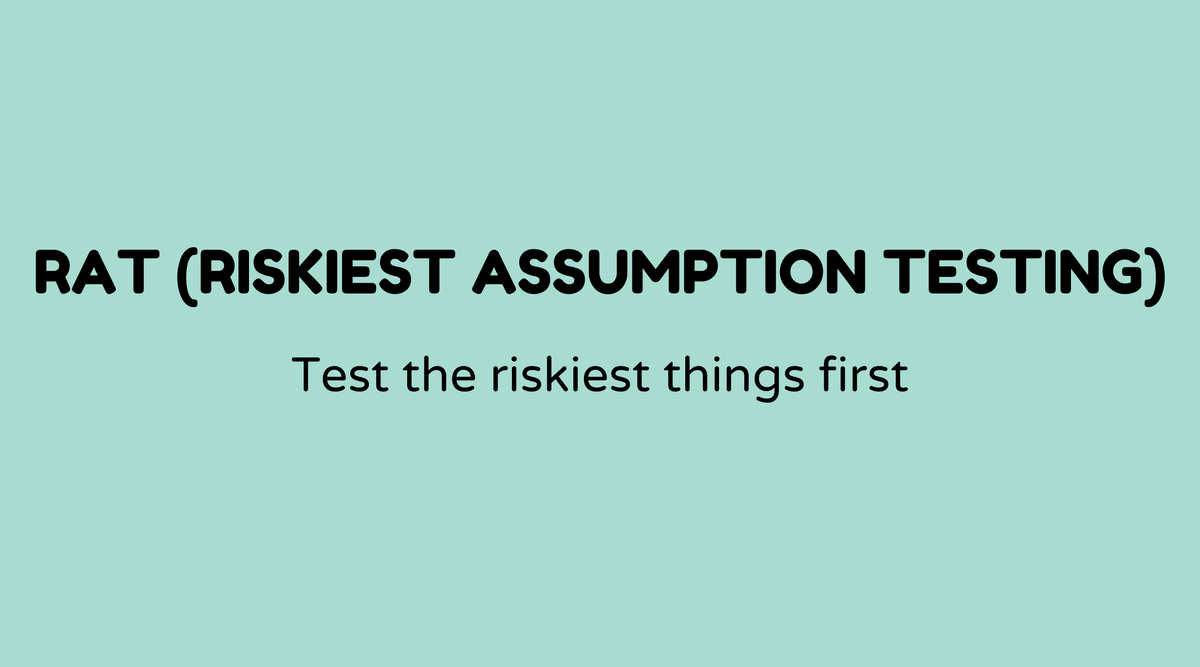RAT (Riskiest Assumption Testing)

Overview of RAT (Riskiest Assumption Testing) Workshop:
The Riskiest Assumption Testing (RAT) Workshop is a valuable tool for startups and innovators. Imagine you're creating a new dish; the RAT Workshop helps you identify which ingredient is most likely to spoil it! This process focuses on pinpointing and assessing the riskiest assumptions that could impact your project.
So why is this workshop important? It’s all about reducing uncertainty. Just like using a safety net while walking a tightrope, the RAT Workshop ensures you're not making leaps of faith without a clear understanding of where you’re landing. We'll examine how this works and why it’s essential to the development of any new product or concept.
Why RAT Workshop Matters:
Let’s be honest, assumptions can feel like those sneaky potholes on a road trip. They can derail your journey if you're not vigilant. The RAT Workshop illuminates those risky areas before you encounter them.
Startups often work with limited resources, and failing to recognize critical assumptions can lead to wasted efforts. By concentrating on the riskiest assumptions, businesses can prioritize actions, conserve resources, and make informed choices. This method accelerates the learning process and cultivates a culture of evidence-based decision-making. Think of it as giving your progress an extra boost to overcome potential hurdles!
What is RAT Workshop:
Let’s break it down. The RAT Workshop is a structured process used to identify and validate the most critical assumptions behind a business model, product, or service. It's where theory meets practice, and ideas connect with reality.
During the workshop, teams highlight assumptions that could disrupt their project if proven incorrect. This involves a mix of creativity and analysis, leading to the development of simple, quick experiments designed to validate or invalidate these assumptions. It’s akin to running a mini-lab, with hypotheses ready to be tested in real-world scenarios.
How do you do RAT Workshop:
Step-by-Step Process of a RAT Workshop:
- Identify Assumptions: Start by listing all the assumptions related to your project. This might include market demand, cost estimates, or technological capabilities.
- Prioritize Assumptions: Not all assumptions hold the same weight. Use criteria like impact and uncertainty to rank them.
- Design Experiments: Create simple, cost-effective experiments to test these assumptions. This could be through customer interviews, prototype testing, or market surveys.
- Execute Tests: Conduct the experiments and collect data with an open mindset. Remember, the goal is to learn!
- Analyze Results: Review the data. Does it support or contradict your assumptions? Make choices based on the evidence collected.
It’s all about iteration. The RAT Workshop is designed to be adaptable, allowing teams to cycle through testing and validation in response to feedback and outcomes.
Sample Agenda of RAT Workshop:
A standard agenda for a RAT Workshop can look like this:
- Introduction & Goals: Define the objectives for the workshop. (15 minutes)
- Identify Assumptions: Brainstorm and list assumptions. (30 minutes)
- Prioritization: Evaluate assumptions using impact versus uncertainty. (45 minutes)
- Experiment Design: Create a plan for testing top assumptions. (1 hour)
- Execution Planning: Assign roles and set timelines for experiments. (30 minutes)
- Closing & Next Steps: Recap key learnings and outline the next steps. (15 minutes)
Examples of RAT Workshop:
Example 1: A tech startup developing a mobile app might assume their primary audience prefers using mobile data over Wi-Fi. Through RAT, they could prioritize and test this assumption first since incorrect assumptions might distort user data and app performance validation.
Example 2: An eco-friendly product company assumes customers are willing to pay a premium for sustainability. By conducting surveys and focus groups as part of their RAT Workshop, they can quickly validate (or invalidate) this assumption before committing resources to marketing and production.
FAQs:
How long does a RAT Workshop usually last?
- A typical RAT Workshop can last from half a day to two days, depending on the complexity and scope of the project.
Who should attend the RAT Workshop?
- Ideally, key stakeholders from relevant departments, including product development, marketing, and customer service, should participate. External consultants can also provide valuable insights.
Can RAT be applied to ongoing projects?
- Absolutely! While highly beneficial in the initial stages of a project, RAT can be applied throughout a project lifecycle to address new assumptions as they arise.
What tools are needed for a RAT Workshop?
- Basic tools include whiteboards, sticky notes, markers, or digital collaboration tools like Miro or Trello for remote teams.
Is RAT limited to tech startups?
- Not at all. RAT is useful across various industries, from healthcare to manufacturing, wherever product viability and market fit are crucial.
How does RAT compare to traditional risk management?
- RAT is more proactive and experimental, focusing on validating assumptions through empirical data, whereas traditional risk management often involves mitigating identified risks through structured protocols.



